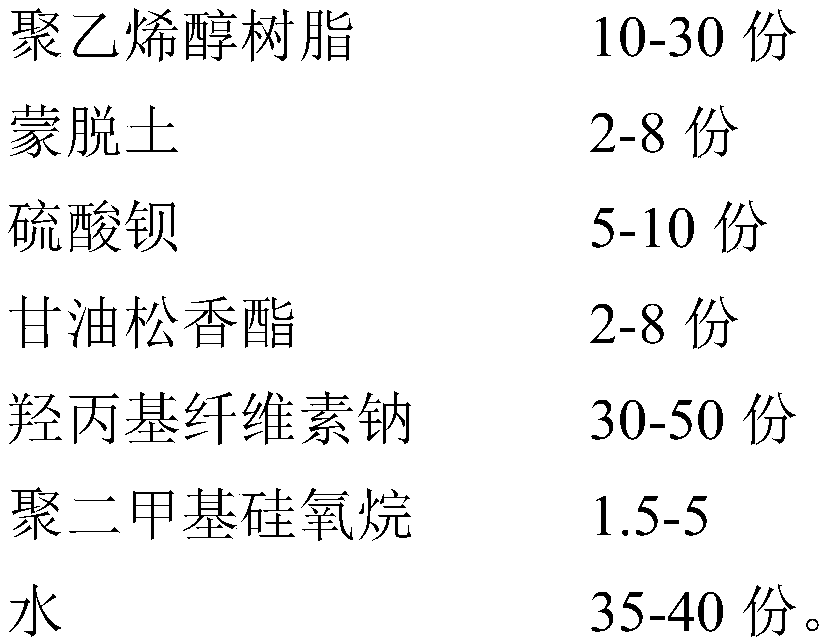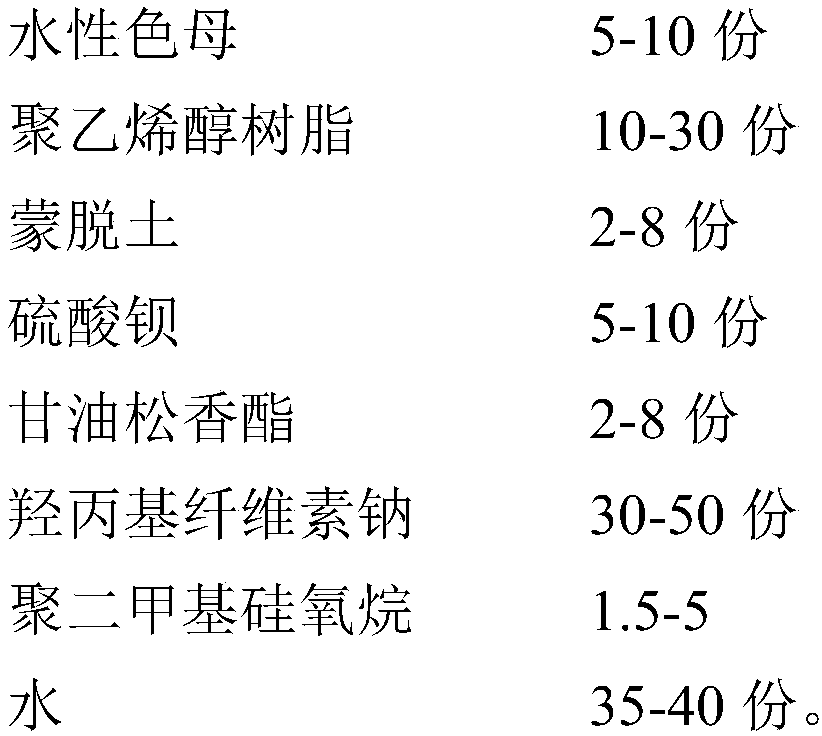Technology for printing water-based ink on PET (polyethylene terephthalate)
A water-based ink and process technology, applied in printing, ink, copying/marking methods, etc., can solve problems such as blurred patterns, inaccurate color registration, and affecting printing effects
- Summary
- Abstract
- Description
- Claims
- Application Information
AI Technical Summary
Problems solved by technology
Method used
Image
Examples
Embodiment 1
[0026] A kind of water-based ink PET transfer printing technique, described technique comprises the steps:
[0027] (1) Put 8 parts of montmorillonite, 5 parts of barium sulfate, and 40 parts of water into the dispersion kettle in sequence, and stir at a speed of 200rpm, then add 10 parts of water-based color masterbatch, stir and mix evenly at a speed of 200rpm, and then use Three-roll mill grinding to a particle size of less than 500nm to obtain an inorganic premix;
[0028] (2) At room temperature, the inorganic premix prepared in step (1), 30 parts of polyvinyl alcohol resin, 8 parts of glycerin rosin ester, 30 parts of sodium hydroxypropyl cellulose, 5 parts of polydimethylsiloxane Stir at a speed of 300rpm for 30min, then filter and discharge to obtain the water-based ink.
[0029] (3) on the PET polyester film, first coat one deck release agent, then use the water-based ink printing pattern, dry;
[0030] (4) Spread the thermal transfer film obtained in step (3) on th...
Embodiment 2
[0032] A kind of water-based ink PET transfer printing technique, described technique comprises the steps:
[0033] (1) Add 2 parts of montmorillonite, 10 parts of barium sulfate, and 35 parts of water into the dispersion kettle in sequence, and stir at a speed of 100rpm, then add 5 parts of water-based color masterbatch, stir and mix evenly at a speed of 150rpm, and then use Three-roll mill grinding to a particle size of less than 500nm to obtain an inorganic premix;
[0034] (2) At room temperature, the inorganic premix prepared in step (1), 30 parts of polyvinyl alcohol resin, 6 parts of glycerin rosin ester, 40 parts of hydroxypropyl cellulose sodium, 1.5 parts of polydimethylsiloxane Stir at a speed of 200rpm for 40min, then filter and discharge to obtain the water-based ink.
[0035] (3) on the PET polyester film, first coat one deck release agent, then use the water-based ink printing pattern, dry;
[0036] (4) Spread the thermal transfer film obtained in step (3) on ...
Embodiment 3
[0038] A kind of water-based ink PET transfer printing technique, described technique comprises the steps:
[0039] (1) Put 6 parts of montmorillonite, 8 parts of barium sulfate, and 40 parts of water into the dispersing kettle in turn, stir at a speed of 150rpm, then add 8 parts of water-based color masterbatch, stir and mix evenly at a speed of 150rpm, and then use Three-roll mill grinding to a particle size of less than 500nm to obtain an inorganic premix;
[0040] (2) At room temperature, the inorganic premix prepared in step (1), 25 parts of polyvinyl alcohol resin, 2 parts of glycerin rosin ester, 50 parts of hydroxypropyl cellulose sodium, 4 parts of polydimethylsiloxane Stir at a speed of 250rpm for 50min, then filter and discharge to obtain the water-based ink.
[0041] (3) on the PET polyester film, first coat one deck release agent, then use the water-based ink printing pattern, dry;
[0042] (4) Spread the thermal transfer film obtained in step (3) on the substra...
PUM
 Login to View More
Login to View More Abstract
Description
Claims
Application Information
 Login to View More
Login to View More - R&D
- Intellectual Property
- Life Sciences
- Materials
- Tech Scout
- Unparalleled Data Quality
- Higher Quality Content
- 60% Fewer Hallucinations
Browse by: Latest US Patents, China's latest patents, Technical Efficacy Thesaurus, Application Domain, Technology Topic, Popular Technical Reports.
© 2025 PatSnap. All rights reserved.Legal|Privacy policy|Modern Slavery Act Transparency Statement|Sitemap|About US| Contact US: help@patsnap.com



